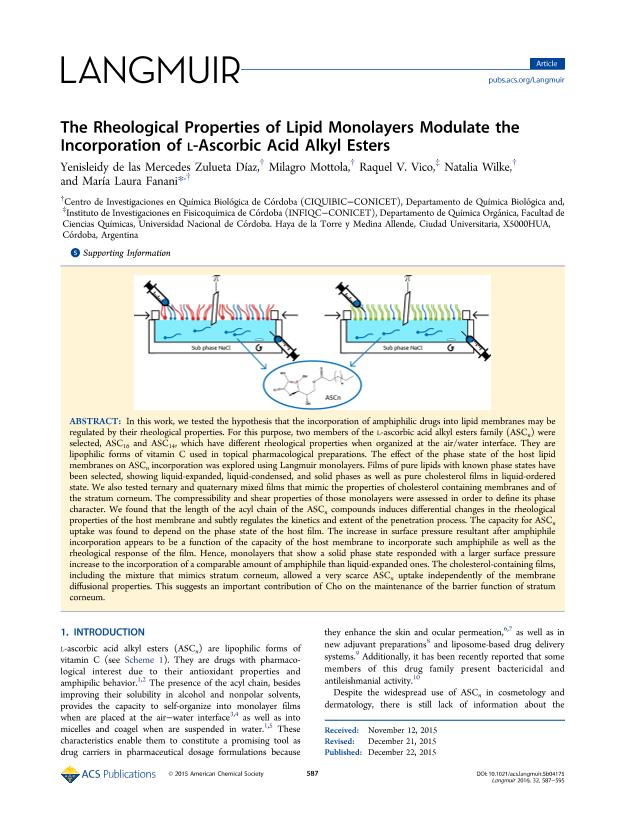Mostrar el registro sencillo del ítem
dc.contributor.author
Zulueta Díaz, Yenisleidy de Las Mercedes

dc.contributor.author
Mottola, Milagro

dc.contributor.author
Vico, Raquel Viviana

dc.contributor.author
Fanani, Maria Laura

dc.date.available
2018-03-22T17:33:25Z
dc.date.issued
2016-01
dc.identifier.citation
Zulueta Díaz, Yenisleidy de Las Mercedes; Mottola, Milagro; Vico, Raquel Viviana; Fanani, Maria Laura; The Rheological Properties of Lipid Monolayers Modulate the Incorporation of l -Ascorbic Acid Alkyl Esters; American Chemical Society; Langmuir; 32; 2; 1-2016; 587-595
dc.identifier.issn
0743-7463
dc.identifier.uri
http://hdl.handle.net/11336/39689
dc.description.abstract
In this work, we tested the hypothesis that the incorporation of amphiphilic drugs into lipid membranes may be regulated by their rheological properties. For this purpose, two members of the l-ascorbic acid alkyl esters family (ASCn) were selected, ASC16 and ASC14, which have different rheological properties when organized at the air/water interface. They are lipophilic forms of Vitamin C used in topical pharmacological preparations. The effect of the phase state of the host lipid membranes on ASCn incorporation was explored using Langmuir monolayers. Films of pure lipids with known phase states have been selected, showing liquid-expanded, liquid-condensed, and solid phases as well as pure cholesterol films in liquid-ordered state. We also tested ternary and quaternary mixed films that mimic the properties of cholesterol containing membranes and of the stratum corneum. The compressibility and shear properties of those monolayers were assessed in order to define its phase character. We found that the length of the acyl chain of the ASCn compounds induces differential changes in the rheological properties of the host membrane and subtly regulates the kinetics and extent of the penetration process. The capacity for ASCn uptake was found to depend on the phase state of the host film. The increase in surface pressure resultant after amphiphile incorporation appears to be a function of the capacity of the host membrane to incorporate such amphiphile as well as the rheological response of the film. Hence, monolayers that show a solid phase state responded with a larger surface pressure increase to the incorporation of a comparable amount of amphiphile than liquid-expanded ones. The cholesterol-containing films, including the mixture that mimics stratum corneum, allowed a very scarce ASCn uptake independently of the membrane diffusional properties. This suggests an important contribution of Cho on the maintenance of the barrier function of stratum corneum.
dc.format
application/pdf
dc.language.iso
eng
dc.publisher
American Chemical Society

dc.rights
info:eu-repo/semantics/openAccess
dc.rights.uri
https://creativecommons.org/licenses/by-nc-sa/2.5/ar/
dc.subject
Ascorbyl Palmitate
dc.subject
Langmuir Monolayers
dc.subject
Drug-Membrane Interaction
dc.subject
Lipid Monolayer Penetration
dc.subject
Stratum Corneum Lipids
dc.subject.classification
Otras Ciencias Biológicas

dc.subject.classification
Ciencias Biológicas

dc.subject.classification
CIENCIAS NATURALES Y EXACTAS

dc.title
The Rheological Properties of Lipid Monolayers Modulate the Incorporation of l -Ascorbic Acid Alkyl Esters
dc.type
info:eu-repo/semantics/article
dc.type
info:ar-repo/semantics/artículo
dc.type
info:eu-repo/semantics/publishedVersion
dc.date.updated
2018-03-21T16:30:57Z
dc.journal.volume
32
dc.journal.number
2
dc.journal.pagination
587-595
dc.journal.pais
Estados Unidos

dc.journal.ciudad
Washington
dc.description.fil
Fil: Zulueta Díaz, Yenisleidy de Las Mercedes. Consejo Nacional de Investigaciones Científicas y Técnicas. Centro Científico Tecnológico Conicet - Córdoba. Centro de Investigaciones en Química Biológica de Córdoba. Universidad Nacional de Córdoba. Facultad de Ciencias Químicas. Centro de Investigaciones en Química Biológica de Córdoba; Argentina
dc.description.fil
Fil: Mottola, Milagro. Consejo Nacional de Investigaciones Científicas y Técnicas. Centro Científico Tecnológico Conicet - Córdoba. Instituto de Investigaciones Biológicas y Tecnológicas. Universidad Nacional de Córdoba. Facultad de Ciencias Exactas, Físicas y Naturales. Instituto de Investigaciones Biológicas y Tecnológicas; Argentina
dc.description.fil
Fil: Vico, Raquel Viviana. Consejo Nacional de Investigaciones Científicas y Técnicas. Centro Científico Tecnológico Conicet - Córdoba. Instituto de Investigaciones en Físico-química de Córdoba. Universidad Nacional de Córdoba. Facultad de Ciencias Químicas. Instituto de Investigaciones en Físico-química de Córdoba; Argentina
dc.description.fil
Fil: Fanani, Maria Laura. Consejo Nacional de Investigaciones Científicas y Técnicas. Centro Científico Tecnológico Conicet - Córdoba. Centro de Investigaciones en Química Biológica de Córdoba. Universidad Nacional de Córdoba. Facultad de Ciencias Químicas. Centro de Investigaciones en Química Biológica de Córdoba; Argentina
dc.journal.title
Langmuir

dc.relation.alternativeid
info:eu-repo/semantics/altIdentifier/url/http://pubs.acs.org/doi/abs/10.1021/acs.langmuir.5b04175
dc.relation.alternativeid
info:eu-repo/semantics/altIdentifier/doi/http://dx.doi.org/10.1021/acs.langmuir.5b04175
Archivos asociados
